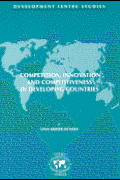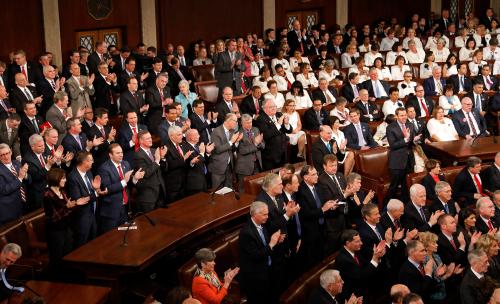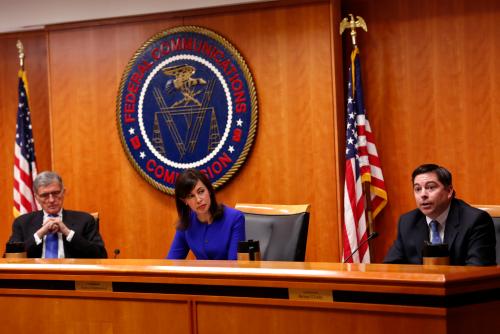TechTakes is an occasional blog series that collects the perspectives of Brookings scholars on timely topics in technology policy. On December 14, the Center for Technology Innovation hosted an event at Brookings titled “Technology policy and the Trump administration” where CTI scholars discussed the new administration’s approach to these issues. Watch video of the event here.
Come January 20, President-elect Donald Trump will have the opportunity to continue or suspend many of the technology-focused initiatives begun by President Obama. These programs included expanding broadband access, training workers for jobs in STEM fields, and building supercomputers, among others. Trump and his advisers may also choose to pursue their own technology policy agenda, and will likely have to react to new developments during his time in office. Brookings experts Stuart N. Brotman, Robin Lewis, Nicol Turner-Lee, and Niam Yaraghi weigh in on what direction technology policy will take in the Trump administration, and how it might react to future technology change.
R&D investment and digital trade
Stuart N. Brotman, Nonresident Senior Fellow, Center for Technology Innovation
President Trump’s initial focus will be on implementing some of his top campaign themes and governing priorities, many of which have significant potential technology impacts. For example, tax reform that lowers the corporate tax rate to 15 percent and offers further accelerated depreciation may help stimulate capital investment in telecommunications networks, which has stalled during the past year.
Expanded tax treatment including tax credits may be proposed for applied research and development, especially if linked to manufacturing activities that may generate more jobs at home. Economic incentives also may be offered to U.S. high-tech companies such as Apple to bring manufacturing jobs back to the U.S., comparable to a widely-publicized deal at the Carrier division of United Technologies. In this area, President Trump may directly intervene on a case-by-case basis, targeting select technology companies that could serve as notable examples of repatriation.
With President-elect Trump’s steadfast opposition to the enactment of the Trans-Pacific Partnership, and with no expected support of it in the 115th Congress, the trade focus will move away from multilateral agreements in favor of bilateral pacts. These agreements may be difficult to develop in practice, since digital technologies and services often transcend geographic borders. Regardless of the form of these agreements, a number of technology issues will receive high priority in them. These include customs duties for digital goods; faster, more transparent customs procedures for U.S. exporters of digital equipment; cross-border data flows; trade secret theft; and safeguarding telecom network competition, including competition with state-owned enterprises.
Financial inclusion for economic growth and prosperity
Robin Lewis, Associate Fellow, Center for Technology Innovation
Technology policy constitutes a key component of the drive to expand engagement with formal financial services. Both in the U.S. and abroad, digital technologies such as mobile phones have advanced access to and usage of formal financial services among underserved groups by rendering these services more convenient, less expensive, and more secure than many traditional alternatives. In the next several years, sustaining—and potentially augmenting—many of the ongoing efforts to develop and scale digital technologies that enable underserved consumers in the U.S. to engage with quality, affordable financial services could support the president-elect’s stated objectives of amplifying economic growth and prosperity.
After all, financial inclusion serves as a key ingredient in fostering entrepreneurship, reducing inequality, promoting financial health, and amplifying economic growth. Under the Obama administration, initiatives to advance financial inclusion through the deployment of digital technologies have received significant attention and support from entities such as the U.S. Department of the Treasury. While President-elect Donald Trump has signaled an general interest in continuing to spur technological innovation generally, to date he has not identified specific policy proposals or goals aimed at expanding financial inclusion through digital or traditional platforms.
If anything, some of his statements have suggested the opposite may occur. For example, Trump’s widely publicized interest in potentially constraining the flow of remittances from the U.S. to Mexico to compel Mexico’s president to build a wall along the U.S.-Mexico border, if put into practice, would have significant negative repercussions not only in Mexico, but also in the U.S. In addition, his anticipated critical posture toward the Consumer Financial Protection Bureau has the potential to undermine a significant safety net. Moving forward, the president-elect should carefully consider the important role digital financial mechanisms play, not only in enhancing individuals’ livelihoods, but also in advancing the macroeconomic growth that is a key goal for all presidents.
Expanding broadband access
Nicol Turner-Lee, Fellow, Center for Technology Innovation
The incoming administration has expressed its intent to lead its policy priorities with an aggressive infrastructure plan. Referring to the infrastructure goals as a “golden opportunity for accelerated economic growth,” the new leadership plans to rejuvenate the domestic economy by spurring more targeted private investments and creating and recovering jobs. Under what will seemingly be a pro-business, nonregulated market, the threat of broadband “overbuild” looms, bringing new meaning to the cliche “if you build it, will they come.” Whereas technology overbuilds have often led to increased competition in certain markets and lowered consumer prices, an oversaturated broadband market can also create network redundancies, faster depreciation of assets, and decreased consumer demand.
The latter of three can be quite substantial given the increased trajectory of internet use since 2000. In the U.S., 84 percent of citizens were online in 2015 compared to 52 percent in 2000, with the highest levels of adoption among the more affluent, highly educated, and younger adults. Further, mobile wireless use has been driving increased rates of digital access. In 2016, the number of smartphone users in the U.S. are 223 million, and is projected to reach 264 million by 2021, thus suggesting that a majority of internet growth is wireless.
Managing supply and demand of broadband services should be at the core of the new administration’s efforts. With unbridled supply, the marketplace will be ripe for competitive offerings and differentiated services, including free or unlimited data plans. Smart digital inclusion plans and programs with clear goals and outcomes should be prioritized to narrow the gap among those who haven’t adopted broadband into their daily lives. Increased investments in digital literacy training, especially within community anchor institutions (e.g., libraries and schools) can cultivate more interest and use. In sum, the new administration’s efforts to expand and maximize infrastructure must equally address the demand for these and other emerging services so that when it’s built, they will indeed come.
The Future of Health Information Technology
Niam Yaraghi, Fellow, Center for Technology Innovation
Under the Trump administration, no other sector will undergo as many fundamental changes as healthcare. However, President-elect Trump’s healthcare policies have been particularly vague; while he is intent on repealing Affordable Care Act, we are not certain about his solutions for replacing it, other than the proposal to allow health insurers to compete in multiple states. While the exact outcomes of such a proposal remain to be carefully analyzed, the idea behind it – fostering competition and relying on the invisible hand of the free market – may be a sound solution to our nation’s health information technology challenges. Every medical provider is now using an Electronic Health Records (EHR) system, but physicians are frustrated with their EHR systems, and exchanging medical data remains a major challenge and cyber-security attacks undermine the privacy of patients more than ever.
In the current system, providers have very little incentive to receive data and absolutely no incentive to send data. Market based proposals such as patient-mediated solutions and centralized health information exchange platforms would eliminate the most important barriers to interoperability and significantly enhance health information exchange. However, to implement these solutions, the government should allow medical providers to meet the demand for information by charging a fee for supplying it. In addition, privacy breaches are more likely to happen in the health care industry than any other sector. According to the Office for Civil Rights (OCR), the medical information of more than 155 million American citizens has been exposed through about 1,500 breach incidents since late 2009. To prevent these breaches and protect patient privacy, OCR should allow the healthcare industry to learn from its failures and create larger incentives for medical providers and their business associates to protect patient privacy. In the long run, a cyber-insurance market will ensure the privacy of patients by creating incentives for different entities in the healthcare sector to prioritize security practices and privacy policies.












Commentary
Alternative perspectives on technology policy in the Trump administration
December 21, 2016